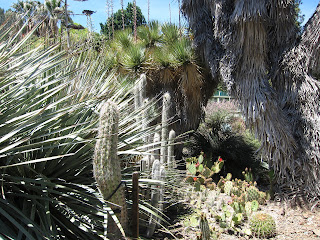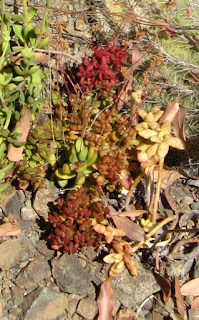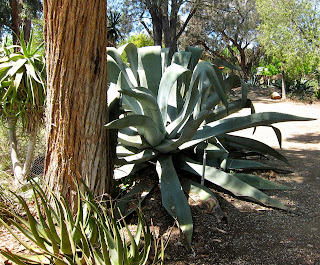 |
| small succulent, flowering |
The Ruth Bancroft Garden in Walnut Creek, California showcases the diversity of succulents.
For hundreds of years, people have enjoyed growing succulents. Most succulents are from dry areas around the world and evolved to tolerate dry conditions. Most deserts around the earth occur at 30o North and South, so the winters are mild. A few succulents can survive really cold conditions, but those are exceptional. That means in northern Colorado where I live, the array of succulents I can find is limited, and in the East Bay of northern California, where I visited, a much greater variety of succulents can be grown.
In general, succulents are easy to grow, requiring very little care if planted in favorable locations. And mostly their idea of a favorable location is some rocky spot in full sunlight, which is often a place where other plants grow poorly.
 |
| Fat succulent leaves on Caprobrotus edulis, ice plant, at Point Reyes |
In cacti,
the stems are succulent |
In the northern California's East Bay, about an hour east of San Francisco, the summers are hot and the winters mild and wet. Here, succulents thrive. In the 1950s, Ruth Bancroft, married to the grandson of California historian and publisher Henry Howe Bancroft, and living on the family farm in Walnut Creek, planted her first succulent and by the 1970s when what is now called the Ruth Bancroft Garden was established at its present site, she had thousands of succulent plants.
 |
| Diverse succuents, Ruth Bancroft Garden |
 |
| The leaves can be brightly colored |
 |
| a group of succulent rosettes |
 |
| A row of cacti bigger than basketballs, Ruth Bancroft Garden |
But succulents perish if they are waterlogged for very long, sooner than most plants. Consequently the Ruth Bancroft Garden puts its plants on mounds so that the plants can reach the water but are not immersed in it. Having or creating good drainage is one of the keys to successfully growing succulents.
Another attraction of succulents is their flowers. Plants that seem plain can become dramatic in flower:
 |
| Agave flowering stalk, Ruth Bancroft Garden. Yes, those are phone lines in the background |
 |
| Non-flowering Agave beside tree, Ruth Bancroft Garden |
 |
| So many flowers you can't see the succulent leaves |
Columnar cacti and agaves are conspicuous succulents of very arid environments. But many succulents simply slip into spots that, for the region, are relatively dry due to a shallow soil or position on the top of a sunny slope. There, they are not conspicious but can be surprisingly common if you know where to look.
Comments and questions welcomed.
For explanation of my use of plant families (Bromeliaceae, pineapple family for example) see previous post: Botany Rules 3: Why do Botanists Always Tell You the Plant Family?
For more on agaves and monocarpy, see previous post: Visiting Northern California: Flowering Agaves!
Kathy Keeler, A Wandering Botanist
More at awanderingbotanist.com
Join me on Facebook







No comments:
Post a Comment